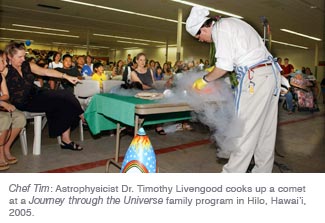|
|
 |
| |
|
 Journey through the Universe
has evolved as a program since its inception in 1991 as a pilot
initiative in Washington, DC. However, it has always embraced—a
community approach to reaching the next generation; the need to tailor
programming to the strategic needs of the community; the ability to
provide a window on the universe and the lives of researchers through
direct program involvement by gifted researchers; and special emphasis
on underserved communities. Journey through the Universe
has evolved as a program since its inception in 1991 as a pilot
initiative in Washington, DC. However, it has always embraced—a
community approach to reaching the next generation; the need to tailor
programming to the strategic needs of the community; the ability to
provide a window on the universe and the lives of researchers through
direct program involvement by gifted researchers; and special emphasis
on underserved communities.
A brief program history is provided
below. General Program Milestones for
the national program, and examples of Community
Achievements reflecting the unique needs of each community, are
also provided.
|
| |
 |
| The Journey through the Universe
program began as a pilot initiative overseen by the Laboratory for
Astrophysics at the Smithsonian’s National Air and Space Museum—the
most visited museum on Earth. Laboratory researchers had been
working on a variety of education programs for many years, including
gallery and IMAX film development, and presentations for the
visitorship. It was clear that unlike our colleagues in academia,
we had the ability to reach children, families, teachers, and the
public, and provide these audiences a window on the process of
scientific exploration. We were also trained to be highly
effective in engaging audiences. Programs were not
lectures. We engaged audiences by helping them to help us tell
powerful stories of Earth and the greater cosmos. We could
provide truly authentic experiences in research on the human frontier,
and at a time when the National Science Education Standards were being
framed and released. |
| |
 |
|
The pilot
initiative began with a recognition that inspiring and educating the
next generation was truly a community effort. If you wanted to
make a lasting impact you not only needed to engage students directly,
but also their teachers and families. This 'Learning Community
Model' was first implemented in 1991-95 using space science content,
with the National Air and Space Museum reaching out to
Washington/Baltimore school districts. It was then expanded to
the National Zoo with a focus on conservation of endangered
species. Three generations of assessment tools were developed to
assess each program component. Data indicated that not only were
children inspired in classrooms by the researchers, but also
their teachers were being given relevant tools and training to continue
the journey, and family programming encouraged educational
conversations between parent and child for weeks afterward.
|
| |
 |
|
The next step was to
pilot the initiative in communities nationally to see if success owed
to the programs being held at the National Air and Space Museum and the
National Zoo. The question: if you could send a national team of
researchers to an underserved community, and these researchers were
gifted at communicating their passion to audiences of all ages, could
you have the same success with programs if they were held in an old
middle school gymnasium, or a community center?
Assessment data for
programming in Aroostook County, Maine, Baton Rouge, Louisiana, Flint,
Michigan, Odessa, Texas, Schenectady New York, and Broken Arrow,
Oklahoma indicated the same level of success as in Washington,
DC. The overwhelming view from attendees was that it was a gift
to their community for these researchers to come and share their
experiences with the community’s children, teachers, and
families. The researchers were viewed as heroes.
|
| |
 |
| Based on the success of the
pilot programs, the Journey through the Universe national
program was launched at the Challenger Center for Space Science
Education with significant grant support from NASA. The national
initiative developed recipes for largescale programming, with
national teams of researchers and educators reaching as many as 12,000
students in a community one classroom at a time, professional
development for 100-300 educators, and family/public programs each for
100-2,000 attendees. The program placed special emphasis on
sustainability, with program operations being taken on by the
community’s Local Team possibly by their year 3. |
| |
 |
|
In 2005, as the NASA grants
were coming to a close, the National Center for Earth and Space Science
Education was established at USRA. The Center formally embraced
the Learning Community Model as its central program paradigm, and Journey
through the Universe was reconfigured for delivery as a product
available to communities nationwide on a strictly cost recovery
basis. Instead of limited federal funds underwriting program
operations in a small number of communities, school districts, local
community foundations, and local governments would be able to
underwrite programming for their communities. It was
recognized that for Journey through the Universe to realize
its potential, it needed to be positioned in the marketplace.
The new Journey through the
Universe National Program was launched with this Web site in
October 2007.
|
|
 |
|
|
